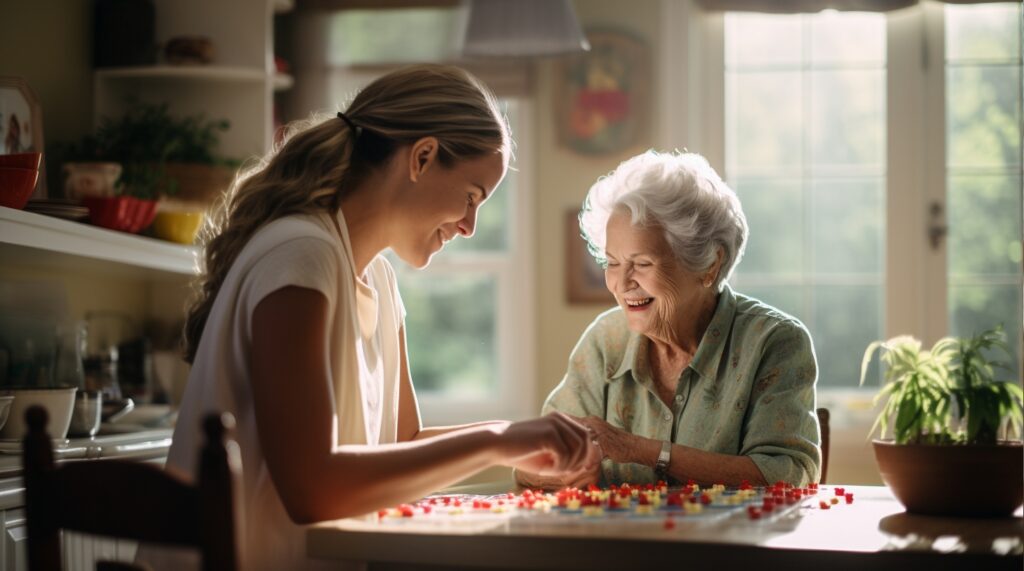In my years immersed in the world of caregiving, I’ve often found myself pausing, weighed down by the myriad emotions that come with watching a loved one age. Those quiet moments, when the hands of the clock seem to slow, are when the gravity of responsibility presses most heavily upon my shoulders. I’ve observed, with both professional insight and personal involvement, the delicate dance between preserving a loved one’s dignity and ensuring their well-being.
Yet, there inevitably arrives a juncture, a tipping point, where the rhythmic ebb and flow of caregiving starts to feel more like an overpowering tide. It’s that indistinct threshold when the demands of care intensify, and both the caregiver and the cared-for are on the brink, teetering between exhaustion and need. At these moments, I often wonder: How do we navigate this terrain without losing ourselves or compromising the well-being of those we hold dear?
 Understanding the Challenge
Understanding the Challenge
The road of caregiving is one fraught with unexpected twists and profound revelations. At the forefront of this journey, I’ve grappled with the undeniable impact it has on those who bear the mantle of care. The weight isn’t merely physical – lifting, assisting, and supporting – but also deeply emotional. It’s the silent tears shed in the quiet hours, the concern that lingers long after visits, and the second-guessing that often plagues our nights.
Yet, as we walk alongside our aging loved ones, another layer of complexity unfolds. Their increasing isolation becomes palpable, their unique needs more pronounced. Whether it’s the longing for conversation, the desire for meaningful engagement, or the specialized medical attention they require, their world begins to shrink, often leaving them ensconced in a cocoon of solitude.
And then, there’s the home – not just bricks and mortar but a sanctuary imbued with decades of memories, laughter, and tears. I’ve come to realize that for many elderly individuals, their home represents more than shelter; it’s a bastion of their identity, a repository of their life’s tales, and a space where they feel truly seen and understood. But how do we balance this deep-seated attachment with the evolving demands of their well-being?
Exploring Alternatives to Nursing Homes
When contemplating the best care setting for our aging loved ones, the landscape of options can feel both vast and yet, paradoxically, limiting. Each alternative comes with its own set of promises and compromises. As I’ve journeyed through the labyrinth of senior care, two particular avenues have captured my attention: Assisted Living and Home Care.

Assisted Living facilities, with their blend of independence and structured care, offer a unique proposition. They promise a sense of community, where residents can forge connections and share experiences, while also preserving the sanctity of personal space. But, in these settings, I often find myself pondering: Can they truly replicate the intimacy and comfort of one’s own home?
On the other hand, Home Care, a rising trend, strikes a different chord. It speaks to the heart’s desire to remain in familiar surroundings, to wake up to the same walls that have witnessed life’s milestones. The pull of Home Care is undeniably strong, and its growth underscores a collective yearning to age gracefully in the embrace of home. But what makes it so appealing? Is it the comfort of the known or the promise of personalized care?
Navigating these choices requires a blend of introspection and foresight, weighing the comforts of the familiar against the allure of specialized care. But, at the heart of it all, lies a singular quest: to find that perfect haven where our loved ones can age with dignity, grace, and joy.
Dismantling Myths and Stereotypes
In my travels and interactions, I’ve been privy to countless conversations about aging and the institutions meant to support this inevitable phase. Time and again, I’ve encountered deeply rooted fears and misconceptions surrounding institutionalization. The specter of cold, impersonal hallways, devoid of warmth and understanding, haunts many. But is this image we’ve collectively painted, often fueled by sensational stories, truly representative of the whole picture?
Long-term care facilities, for all the flak they receive, are not monolithic entities. While there may be outliers that fail to meet the mark, many are bastions of care and support, driven by professionals who are deeply committed to their craft. We must differentiate between isolated incidents and the broader reality. Might it be that our fears are more a reflection of our apprehensions about aging than the institutions themselves?
However, the onus is not solely on the public’s perception. Institutions must also rise to the occasion, continuously striving to better their services and addressing genuine concerns. Transparency, open dialogue, and consistent efforts to improve can go a long way in dispelling these myths.
In our quest for the best care for our loved ones, I urge everyone to approach the topic with an open heart and mind. Let’s educate ourselves, ask the tough questions, and truly understand the landscape before passing judgment. Only then can we hope to make decisions rooted in knowledge and compassion, rather than fear.

The Benefits and Limitations of Home Care
The allure of home care lies in its inherent promise: to provide tailored, compassionate support within the walls of one’s cherished abode. From my vantage point, I’ve seen the profound impact of such personalized interventions. It’s more than just medication routines or physical therapy sessions; it’s about understanding the intricate fabric of an individual’s life and weaving care into it seamlessly. There’s unmatched beauty in witnessing a senior dance to their favorite tune or garden in their backyard while receiving the care they need.
Yet, the heart of home care’s appeal is, without doubt, the preservation of independence. I’ve met countless elders who, despite their frailty, beam with pride as they recount tales of their youth or show off trinkets collected over a lifetime. To them, home is not just a physical space; it’s an embodiment of their life’s journey. Uprooting from this sanctuary, even for the sake of medical care, can be a jarring experience.
However, as with all things, home care is not without its challenges. Financial constraints often loom large, with families grappling to strike a balance between quality care and affordability. Logistically too, ensuring round-the-clock care or adapting a house to cater to mobility needs can be taxing.
As I’ve navigated these waters, a recurring thought has anchored me: while home care offers a world of benefits, it’s essential to approach it with eyes wide open, recognizing both its potential and its limitations. Only with this balanced perspective can we truly harness its power and offer our elderly the dignified, loving care they so richly deserve.
Strategies to Enhance Home Care
In my many interactions and deep dives into the realm of home care, I’ve often been drawn to the question: How do we elevate the experience for our seniors? Beyond the basics of health and safety, how can we enrich their lives and truly make their golden years shine?
A cornerstone of effective home care, I believe, lies in promoting self-sustenance. There’s an innate strength and confidence that comes from being able to perform daily tasks, no matter how small. From brewing their morning tea to tending to their garden, these acts not only foster a sense of independence but also infuse a dash of normalcy into their ever-changing world.
However, while the privacy of one’s home is cherished, it’s equally vital to strike a balance with socialization. I’ve seen the transformative power of community, where seniors can share stories, relive memories, and forge new connections. This community culture doesn’t necessarily mean stepping out; it can be as simple as virtual calls, neighborhood gatherings, or even shared hobby classes. The essence is to ensure they are connected, not isolated.
Lastly, and perhaps most importantly, the role of family cannot be understated. The ties that bind us are our strongest anchors. Extended visitations, weekend stays, or even daily calls can make a world of difference. It’s not just about physical presence; it’s about letting them know they are loved, valued, and never truly alone.
Navigating the maze of home care is no simple task, but with a blend of empathy, foresight, and innovation, we can pave a path that’s not just about living, but truly thriving.
